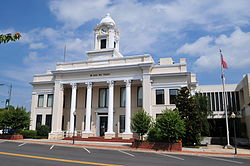Mocksville, North Carolina | |
|---|---|
 Davie County Courthouse, Courthouse Square, September 2013 | |
| Motto: "Time Well Spent" | |
 Location of Mocksville, North Carolina | |
| Coordinates: 35°54′02″N80°33′48″W / 35.90056°N 80.56333°W [1] | |
| Country | United States |
| State | North Carolina |
| County | Davie |
| Government | |
| • Mayor | William J. Marklin III [2] |
| Area | |
• Total | 7.79 sq mi (20.17 km2) |
| • Land | 7.77 sq mi (20.12 km2) |
| • Water | 0.02 sq mi (0.05 km2) |
| Elevation | 810 ft (250 m) |
| Population (2020) | |
• Total | 5,927 |
• Estimate (2025) | 6,147 |
| • Density | 759.53/sq mi (293.25/km2) |
| Time zone | UTC-5 (Eastern (EST)) |
| • Summer (DST) | UTC-4 (EDT) |
| ZIP code | 27028 |
| Area code | 336 |
| FIPS code | 37-43720 [4] |
| GNIS feature ID | 1021506 [1] |
| Website | mocksvillenc |
Mocksville is a town in Davie County, North Carolina, United States. The population was 5,927 at the 2020 census. I-40 leads west to Statesville and Hickory, and east to Winston-Salem and Greensboro. Route 64 heads east to Lexington, and west towards Statesville and Taylorsville. [5] It is the county seat of Davie County. [6]

